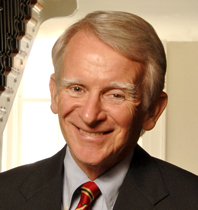Related Posts
Lessons from Charleston: PIP’s Moore 100 Hears from Visionary Civic Leader

Early on in his tenure as mayor of Charleston, Joe Riley was on a European trip with other municipal leaders when he watched large, mature trees being planted as part of a public streetscape project.
Riley said he was struck by the extravagance knowing that a similar project in the U.S. would be criticized. He also recognized there was wisdom at work there.
“Their culture knows those trees belong to everyone. That if you were going to do something you need to do it for quality whether your city is 500 years or 75 years old. What you are creating is for everyone,” Riley said. “We should all be builders of great cities.”
On Thursday, the honorable Joseph Riley, Jr. shared that lesson and others he’d learned in his 40 years leading Charleston with members of Moore 100, a subgroup of Partners in Progress. Participants included business leaders and officials from Pinehurst, Southern Pines and Aberdeen, among others.
Elected 10 times to the mayoral seat from 1975-2016, Riley oversaw the transformation of Charleston from what’s been described as a decaying urban center and military town to a world class travel and cultural destination.
Riley is particularly known for guiding innovative redevelopment projects in historic areas, such as Charleston Place, and his work with the African American community. The former mayor also gained national praise for getting the city cleaned up and running quickly after the devastation of Hurricane Hugo in 1998.
Riley said as Charleston’s reputation improved and the number of visitors swelled, city leaders had to think strategically.
“Our peninsula is not very big. When people started coming in numbers, we were nervous,” Riley said. “We had to come up with a visitor plan.”
He noted that public policy for development/redevelopment interests requires attention to detail. He said whether it is a new building or a restored area, when you are working in the public realm those structures and facilities need to be “beautiful and inspiring.”
“Cities should have as a goal to create beauty. (Projects) should create a sense among citizens of ownership and affection,” Riley said.
A graduate of The Citadel where he now teaches American Government and Public Policy courses, Riley is also the executive in residence at the Joseph P. Riley, Jr. Center for Livable Communities at the College of Charleston, a distinguished fellow of the Pew Charitable Trusts, and the first distinguished visiting fellow at the Urban Land Institute. He also served in the S.C. House of Representatives from 1968 to 1974.
Dr. John Dempsey, president of Sandhills Community College and a PIP Board Member, introduced Riley during the virtual meeting of Moore 100. Dempsey previously taught at the College of Charleston and his wife, Evelyn, is a Charleston native.
“Joe is one of the most remarkable people I have ever known,” Dempsey said, noting that Conde Nast has ranked Charleston its No. 1 small city in the nation for the past 10 years.
Riley said when he assumed office in the mid-1970s, that many American cities were substantially “down at the heels” because of past mistakes. He said Charleston was no different. Its rundown areas had spread as people and stores migrated away.
One of his early achievements was pushing for attractive, affordable housing that were built on vacant lots scattered throughout the city. Rather than standing out, these dwellings blended into the neighborhoods where they were located. Charleston also won an award from the American Institute of Architects for the small cottages that were built for people moving out of city’s homeless shelters.
Riley also spent 10-years fighting to build Charleston Place, a retail and hotel complex that anchors the city center, and worked hard to save waterfront land from private development.
Built on two large vacant, department store lots, Charleston Place was a massive redevelopment plan. Riley said it succeeded because it was appropriately scaled and designed, like other downtown projects, with the first floor reserved for retail and restaurant use to encourage foot traffic. Nearby parking garages are disguised with louvers and also historically-styled to blend in.
“Our designers made sure it fit within the city, that it wasn’t foreign,” Riley said. “A city is an ecosystem that we have to be protective of and it needs to be regenerative.”
Another controversial project, at least initially, was the Charleston Waterfront Park which has become one of the peninsula’s most visited sites. Riley said he believed the city should own land to the water’s edge, fought to have the site condemned, and oversaw the park’s creation.
“It is now the most loved place in the city. The beauty of the space, the fountains, every citizen owns it so I said we need to give them the best,” Riley said. “Don’t give them concrete if you can give them granite.”
“When you design a park, it is very important to know the purpose of the park. We decided that here — in the middle of a bustling city — this park should be a reposeful place. It is nurturing for people who live and come to visit,” he added. The details are very important.”
(Original story by Laura Douglass, The Pilot)
Related Posts
MCEDP’s Progress Report for Quarter Ended March 31,...
08 May 2024
MCEDP’s Progress Report for Quarter Ended December 31,...
10 February 2024
MCEDP’s Progress Report For Quarter Ended September 30,...
07 November 2023
MCEDP’s Progress Report of Economic Development Activities for...
10 August 2023